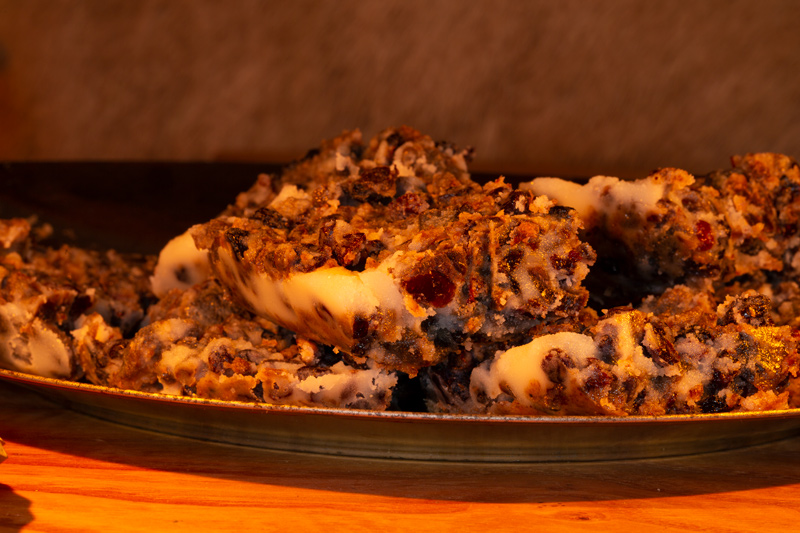Clark and Lewis are ceremoniously carried into a Lakota Sioux village where they are feted with food and music. Clark sees several recently captured Omaha prisoners and asks for their return.
Evening of Ceremony with the Teton Sioux—September 26, 1804
36″ x 54″ oil on canvas
© 2009 by Charles Fritz. Used by permission.
Curious Indians
the river lined with indians, came too & anchored by the particular request of the Chiefs to let their Womin & Boys See the Boat, and Suffer them to Show us some friendship—
—William Clark
Ceremonial Arrival
they Spread a Buffaloe robe dressed white on the Ground for him to Git on as Soon as he landed he Set on it 8 of the Savages carried him to the lodge which is a Great Mark of friendship.
—John Ordway
Pemmican by Candlelight
© 2020 by Kristopher K. Townsend. Permission to use granted under the Creative Commons Attribution-Share Alike 4.0 International license.
Sioux Delicacies
We smoked, and he again harangued his people, after which the repast was served up to us. It consisted of the dog which they had just been cooking, this being a great dish among the Sioux, and used on all festivals; to this were added, pemitigon [pemmican], a dish made of buffalo meat, dried or jerked, and then pounded and mixed raw with grease and a kind of ground potato [large Indian breadroot], dressed like the preparation of Indian corn called hominy, to which it is little inferior. Of all these luxuries which were place before us in platters with horn spoons, we took the pemitigon and the potato, which we found good, but we could as yet partake but sparingly of the dog.
—William Clark paraphrased by Nicholas Biddle[1]Nicholas Biddle, Ed., History of the Expedition Under the Command of Captains Lewis and Clark to the sources of the Missouri and thence across the Rocky Mountains and down the River Columbia to the … Continue reading
Music and Dancing
Several men with Tamborens [tambourines] highly Decorated with Der & Cabra Hoofs to make them rattle, assembled and began to Sing & Beat— The women Came forward highly decerated with the Scalps & Trofies of war of their fathes Husbands & relations, and Danced the war Dance
—William Clark
Omaha Prisoners
in the evening I walked on Shore, and Saw Several Mahar [Omaha] Womin & Boys in a lodge & was told they were Prisones laterly taken in a battle in which they killed a number & took 48 prisoners— I advised the Chiefs to make peace with that nation and give up the Prisoners, if they intended to follow the words of their great father they promised that they would do So—
In this Tribe I saw 25 Squars and boys taken 13 days ago in a battle with the mahars in this battle they Destroyd 40 lodges, killed 75 men, & Som boys & children, & took 48 Prisones Womin & boys which they promis both Capt. Lewis and my Self Shall be Delivered up to Mr. Durion [Pierre Dorion, Sr.]
—William Clark
Weather Diary
Thermot. at rise
Weather Wind at rise
thermotr. at 4 P.M. Weather Wind at 4 oC. P.M 54 fair W 78 fair S. W. —Meriwether Lewis[2]To assist the reader, the editor of this web page has omitted the “day of the month” column and spelled out some abbreviations.
Bad River Encounter Site is a High Potential Historic Site along the Lewis and Clark National Historic Trail managed by the U.S. National Park Service. The site is located in Fischers Lilly Park of the city of Fort Pierre.
Notes
| ↑1 | Nicholas Biddle, Ed., History of the Expedition Under the Command of Captains Lewis and Clark to the sources of the Missouri and thence across the Rocky Mountains and down the River Columbia to the Pacific Ocean. Performed during the years 1804–5–6. By order of the Government of the United States (New York: The Heritage Press, 1962), 53. |
|---|---|
| ↑2 | To assist the reader, the editor of this web page has omitted the “day of the month” column and spelled out some abbreviations. |
Experience the Lewis and Clark Trail
The Lewis and Clark Trail Experience—our sister site at lewisandclark.travel—connects the world to people and places on the Lewis and Clark Trail.
Discover More
- The Lewis and Clark Expedition: Day by Day by Gary E. Moulton (University of Nebraska Press, 2018). The story in prose, 14 May 1804–23 September 1806.
- The Lewis and Clark Journals: An American Epic of Discovery (abridged) by Gary E. Moulton (University of Nebraska Press, 2003). Selected journal excerpts, 14 May 1804–23 September 1806.
- The Lewis and Clark Journals. by Gary E. Moulton (University of Nebraska Press, 1983–2001). The complete story in 13 volumes.





